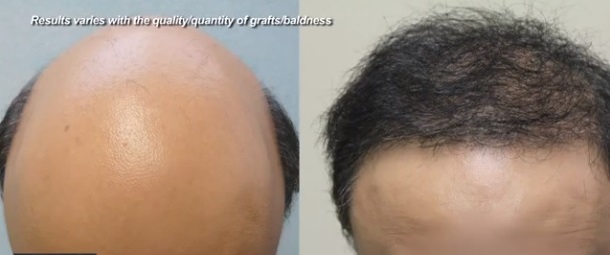
HAIR LOSS
People usually lose their hair because of pattern baldness, or androgenic alopecia. This permanent genetic cause of thinning can manifest in varying degrees, from minor hairline recession to total baldness. It originates from weak androgen receptors inherited through the parents’ X chromosomes; the inherited condition causes scalp hair to shrink and disappear at the presence of DHT, a common hormone. Other causes of extreme thinning are:
- Prior botched hair restoration surgery
- Accident/burn
All of these result from some degree of scarring and/or donor hair depletion, especially prior botched procedures.

HAIR RESTORATION FOR SEVERE HAIR LOSS
Surgical hair restoration for severe hair loss is relatively new, and rests entirely on body hair transplant technology. Body hair transplant, or BHT, uses follicular unit extraction, or FUE, as its basis. FUE harvests hair by using a .8 to 1.2mm punch tool to excise individual follicular units directly from the scalp. This minimally invasive technique avoids the major scarring caused by every other method, allows for faster healing times, and facilitates a broader donor pool.
Body hair transplant widens the donor pool even further by venturing into non-head hair, including the legs, arms, shoulders, chest, stomach, and beard.

The long-term graft survival rate for body hair is not as high as that of traditional scalp hair, but is still high enough, at 80%, to proffer satisfactory results in the event of severe hair loss. And although beard and body hair will continue to act innately in texture, color, growth speed, and length, an advanced surgeon will be able to blend it so well that onlookers won’t know the difference. Body hair transplant has the power to execute remarkable transformation.
As BHT is mobilized to global resource status, it has received acknowledgement in several reputable medical journals for its capacity to restore and repair the “impossible” cases. Both the Annals of Plastic Surgery and the Archives of Dermatology have recently recognized that BHT is changing the future of hair transplant. Sufferers of advanced male pattern baldness, victims of botched surgery, or those who’ve endured an accident or burn now have a chance at complete restoration.
Of course, this technique is only possible in the care of the most advanced FUE surgeons in the world who are adept at using handheld tools. Finding a surgeon may prove difficult, but not impossible.

PHOTOS AND VIDEOS
Severe hair loss correction shown in photos and videos is the visual testimony a prospective patient needs to help decide what surgeon he will use. These results demonstrate a level of skill (or lack thereof) needed to triumphantly execute body hair transplant. The prospective patient should scrutinize hairline design, detail of the crown whorl, and evenness of coverage; making sure the images show the outcomes from several different angles in focus and in good light. Avoid photos and videos that have been tampered with through editing or retouching—enhancing the result compromises the honesty of the image.

FAQ
Who is a candidate for body hair transplant?
Any candidate must not have allergies to anesthesia, blood clotting problems, or scarring tendencies. Being over the age of 24 is also a requirement, and it goes without saying that the patient must suffer severe hair loss, but have enough body hair to serve as a donor supply.
Can women undergo body hair transplant?
Yes, it is possible for women to undergo BHT as long as they meet the criteria above.
How much does hair transplant cost?
FUE can cost between $5 and $12 per graft. Multiply this dollar amount by the quantity of grafts you need in order to get a rough price estimate.
Learning about actual patient experiences can be very insightful. Here is a video of a Norwood 7 patient who was able to achieve excellent results through hair restoration that incorporated body hair follicles. Click here to watch.

